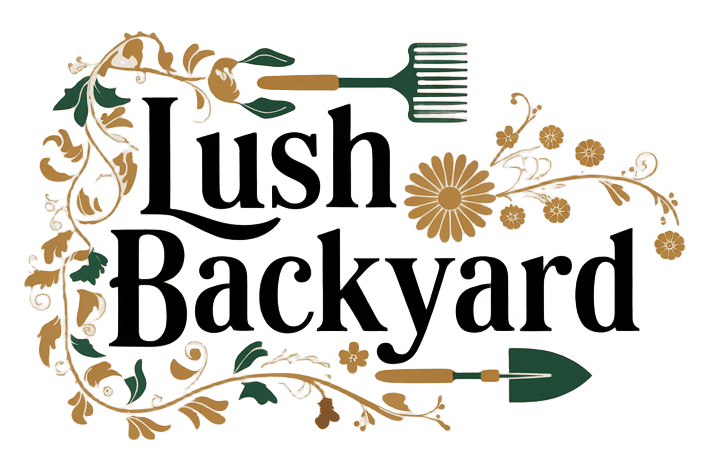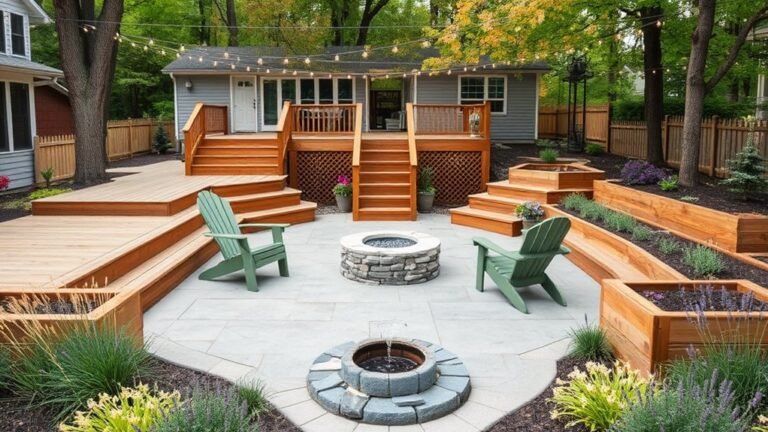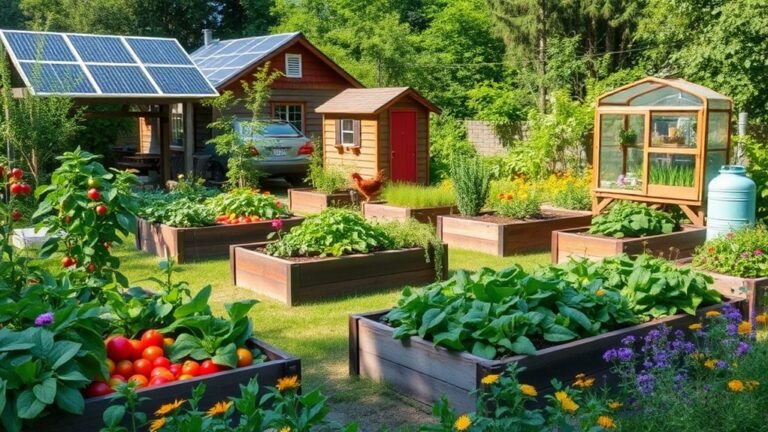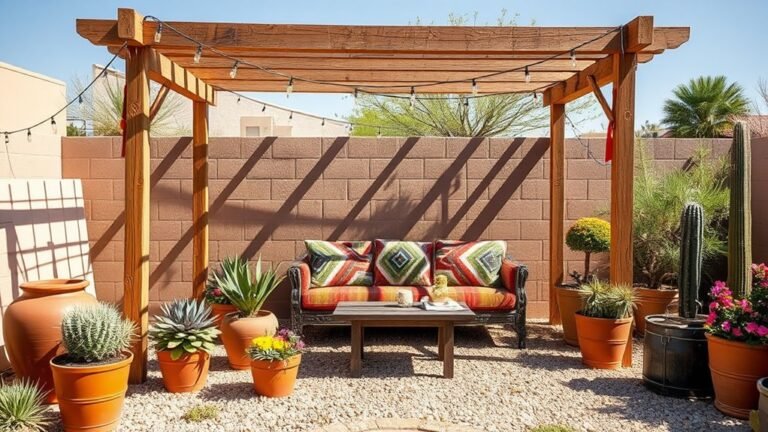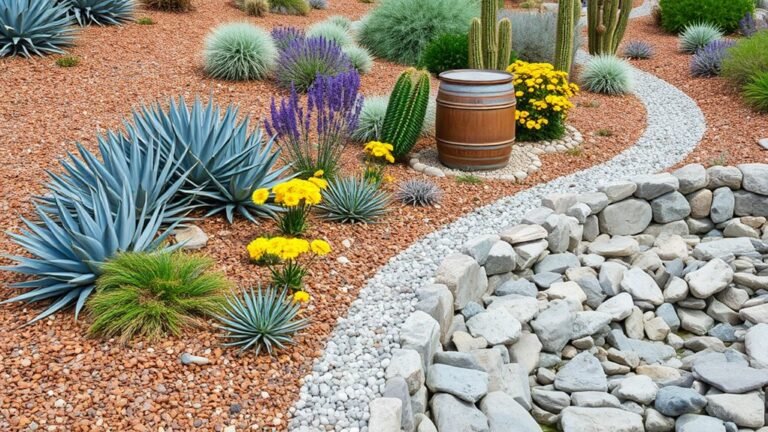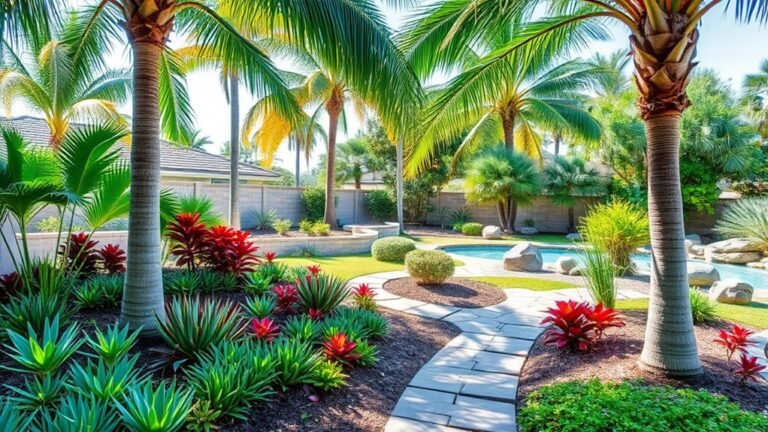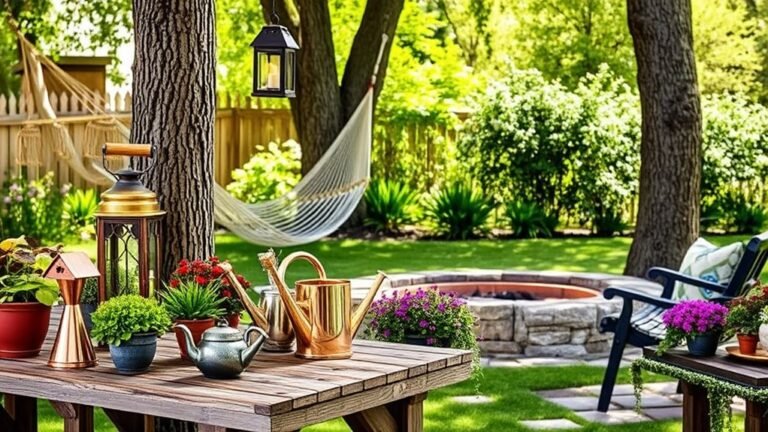13 Drought-Tolerant Backyard Ideas for Water Conservation
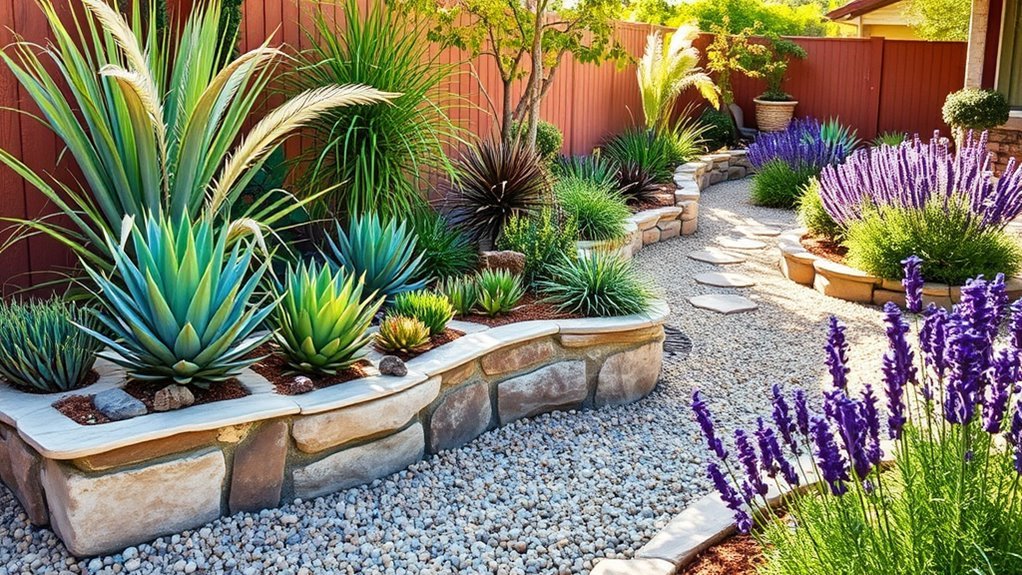
A lush backyard can actually thrive even in the harshest drought conditions through various drought-tolerant ideas. By selecting native plants that require minimal irrigation and incorporating efficient irrigation systems, you can achieve a beautiful outdoor space while conserving water.
As you plan to transform your backyard into a sustainable haven, there are practical solutions to consider that blend aesthetics with functionality. What will be your first step toward this eco-friendly change?
Native Plant Selection
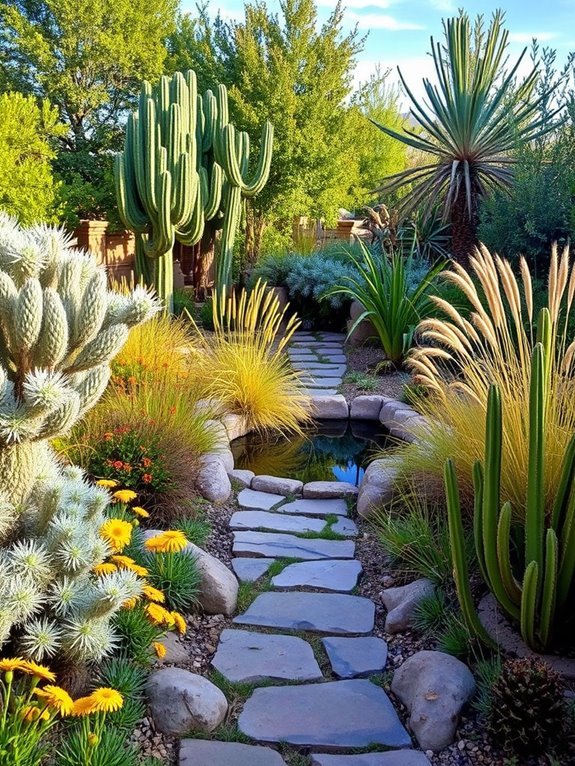
When planning your backyard for water conservation, choosing native plants is a smart move. These plants are well-suited to your local climate and soil, saving you water, time, and money.
Native plants need less watering and maintenance, allowing you to enjoy your outdoor space more.
Imagine vibrant wildflowers and hardy shrubs that thrive effortlessly. You won't have to water them daily or worry about wilting in the sun.
Additionally, native plants attract local wildlife, such as butterflies and birds, bringing life and color to your backyard—a nature party right outside your door!
Who doesn't love a low-maintenance garden? You'll feel like a gardening wizard, creating beauty with minimal effort.
Explore local nurseries and select some native plants for your yard. Your future self will appreciate the flourishing landscape with less care—water conservation has never looked better!
Xeriscaping Techniques
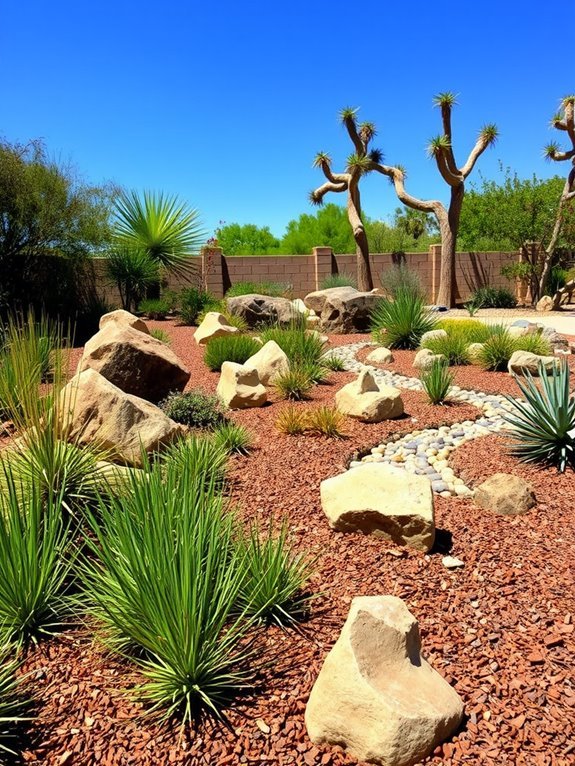
Xeriscaping techniques can turn your backyard into a beautiful, water-efficient oasis by incorporating drought-resistant plants and smart landscaping choices. This not only conserves water but also significantly reduces maintenance efforts. Picture vibrant blooms and lush greenery thriving with minimal moisture!
To begin, consider these key techniques:
| Technique | Description |
|---|---|
| Group Plants | Cluster plants with similar water needs to simplify and enhance irrigation efficiency. |
| Use Mulch | Apply mulch to retain soil moisture, prevent weeds, and ensure plant health. |
| Select Native Plants | Opt for native plants suited to your climate, as they require less water. |
| Install Drip Irrigation | Use a drip irrigation system to deliver water directly to plant roots, minimizing evaporation and waste. |
Rock Gardens
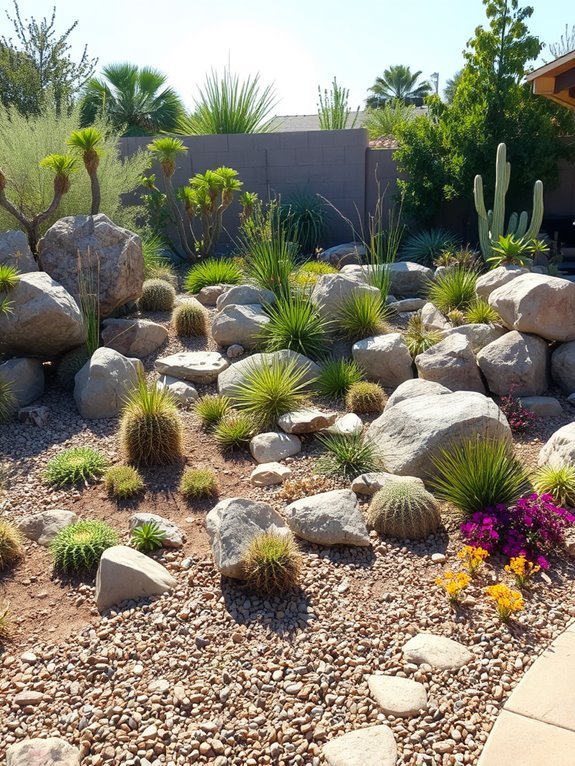
Incorporating rock gardens into your landscape design enhances water conservation efforts while adding visual interest to your backyard. By utilizing rocks and drought-tolerant plants, you create a natural environment that thrives on minimal moisture.
Picture a sunny afternoon sipping lemonade as you admire the beauty of your rock garden—how relaxing!
When designing your rock garden, use various sizes and colors of rocks for depth and texture. Include native plants like succulents or lavender to add liveliness. Rock gardens also attract butterflies and bees, enriching your space with nature's charm.
Don't worry about being an expert—start small! A simple arrangement of rocks and a few plants can create a significant impact. You'll impress your neighbors with your creativity and eco-friendly choices.
Drought-Resistant Grasses
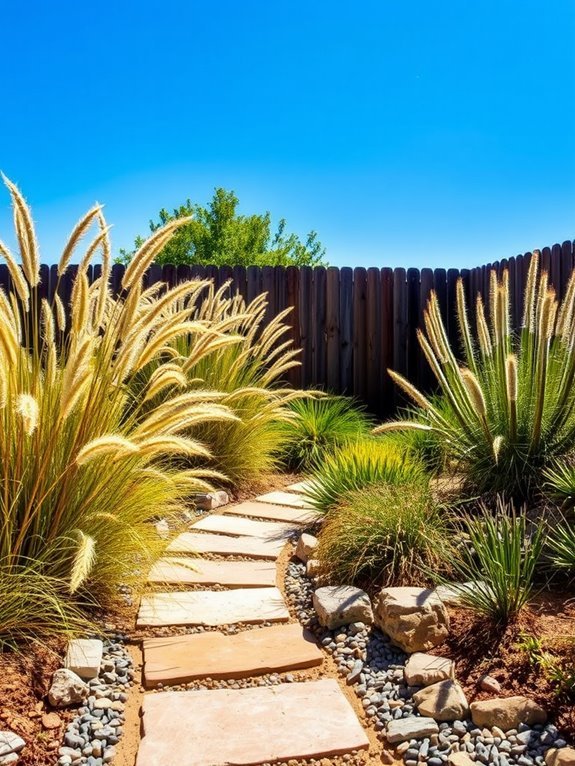
Many homeowners desire a lush, green lawn, but choosing drought-resistant grasses like Bermuda and fescue offers a sustainable and beautiful alternative.
These grasses thrive in dry conditions, reducing the need for frequent watering and allowing more time for leisure activities.
Drought-resistant grasses are resilient, remaining vibrant in harsh sunlight while requiring less mowing. This means fewer trips to the shed and more enjoyment of your outdoor space, all without the guilt of overwatering.
Opting for these grasses is a smart investment in your home. They're easy to maintain, resilient to foot traffic, and ideal for family gatherings or playtime with pets.
Transform your lawn with drought-resistant grasses and create an eco-friendly landscape that will impress your neighbors!
Succulent Arrangements
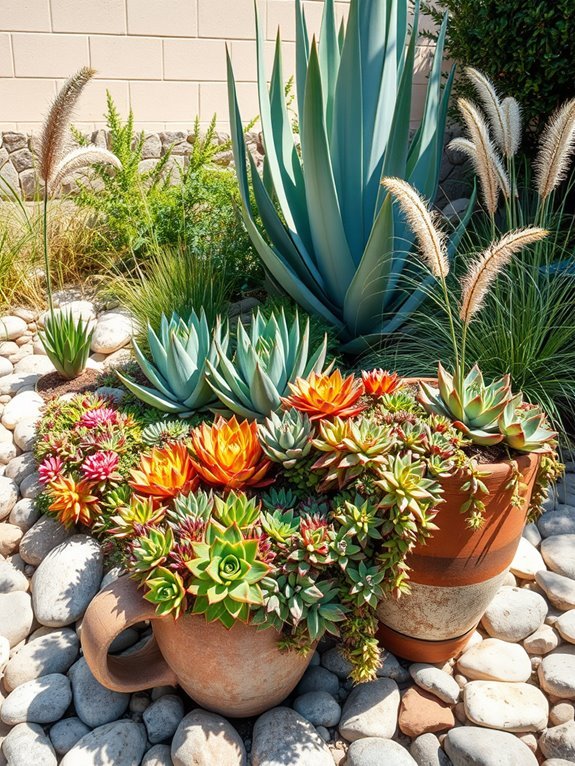
Creating beautiful succulent arrangements enhances your backyard while conserving water. These low-maintenance plants allow for creative displays with various shapes, sizes, and colors that will impress your neighbors.
Choose a selection of succulents suited to your climate, including a mix of tall and short varieties for added depth. Unique containers like old teacups or wooden crates can add charm.
For an appealing layout, position taller succulents in the center and surround them with shorter ones. Ensure they receive plenty of sunlight, as these plants thrive in bright conditions.
Water sparingly, as succulents prefer dry conditions.
Enjoy a vibrant, drought-tolerant garden that remains fresh with minimal effort. Happy gardening!
Rain Gardens
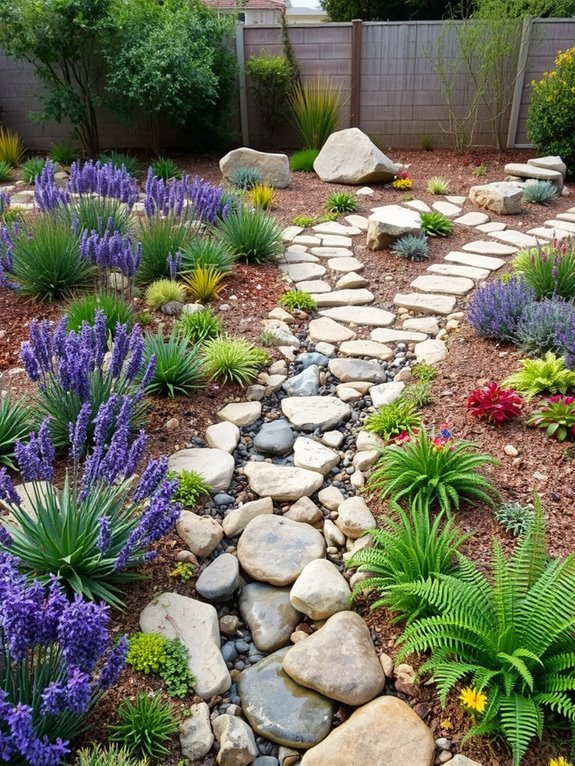
Have you ever thought about how a rain garden can turn your backyard into an eco-friendly haven?
Envision a vibrant patch of plants that absorb rainwater and minimize runoff while adding charm to your space. It's like giving Mother Nature a cozy hug right in your yard!
Creating a rain garden isn't only beneficial for the environment but also enjoyable. Start by selecting a low area in your yard where water tends to collect.
Dig it out slightly and plant native species that thrive in wet conditions—colorful wildflowers, cheerful grasses, and striking shrubs. These plants will absorb excess rainwater and attract butterflies and bees, making your garden a lively hub!
Moreover, rain gardens help filter pollutants, keeping local waterways cleaner.
So, while enjoying a BBQ in your backyard, you can take pride in contributing to environmental health. It's nature's way of offering thanks with a touch of beauty.
Grab your gardening gloves and get started—your rain garden is ready to flourish!
Let's make your backyard the talk of the town, one raindrop at a time!
Mulching Strategies
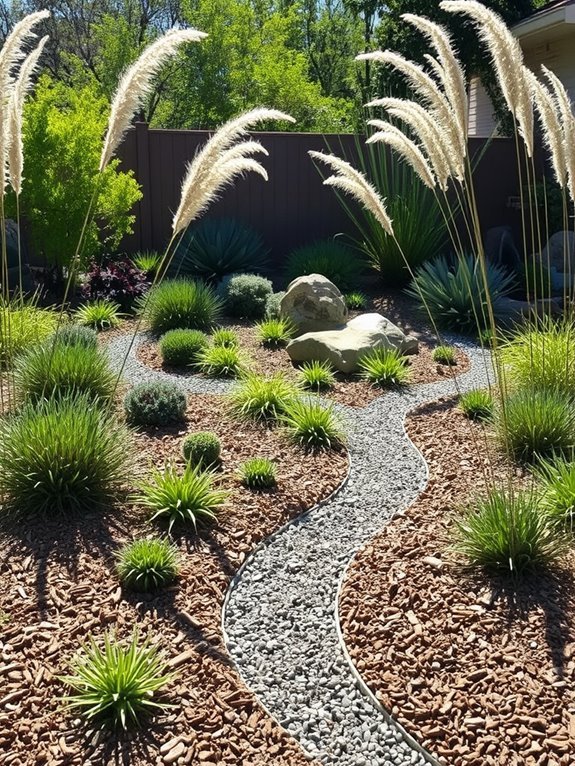
To enhance your backyard's water conservation, mulching is essential. It retains soil moisture, suppresses weeds, and keeps plants comfortable during hot days.
Choosing the right mulch is crucial. Organic options like wood chips and straw decompose over time, enriching the soil. Inorganic choices, such as rubber and gravel, are more durable but lack nutrient benefits.
Refer to this table for a quick guide on mulch types:
| Type of Mulch | Benefits | Best Use |
|---|---|---|
| Wood Chips | Retains moisture, adds nutrients | Flower beds, trees |
| Straw | Lightweight, biodegradable | Vegetable gardens |
| Rubber | Long-lasting, low maintenance | Pathways, ornamental gardens |
| Gravel | Excellent drainage | Rock gardens, dry areas |
| Bark Mulch | Attractive, retains moisture | Around shrubs and trees |
Drip Irrigation Systems
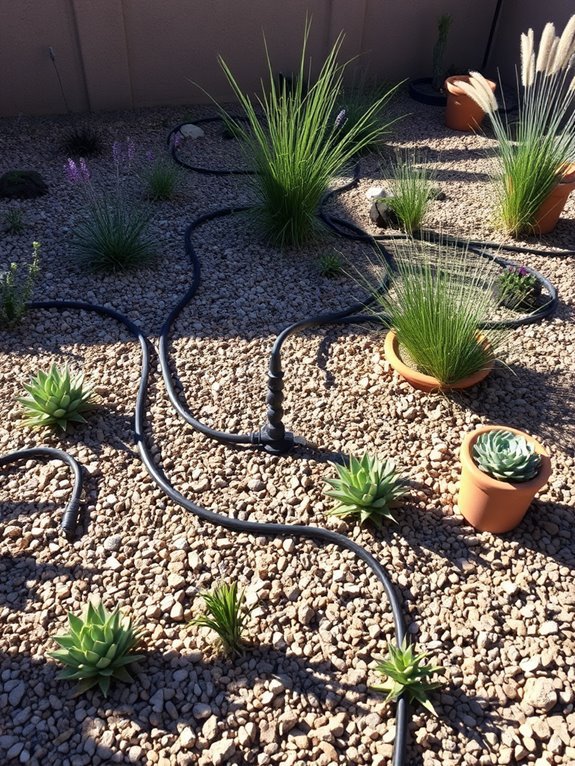
A drip irrigation system transforms garden watering by delivering moisture directly to the roots. Say goodbye to wasteful sprinklers that miss your plants!
With drip irrigation, you can target specific areas and provide just the right amount of water, reducing opportunities for weeds to thrive.
Setting it up is simple: lay out the tubing, attach emitters, and let gravity do the work. You can even schedule watering while you relax with a lemonade.
Additionally, it's a significant water saver, helping you conserve resources while maintaining a lush garden.
You can connect it to a rain barrel for added eco-friendliness!
Permeable Paving
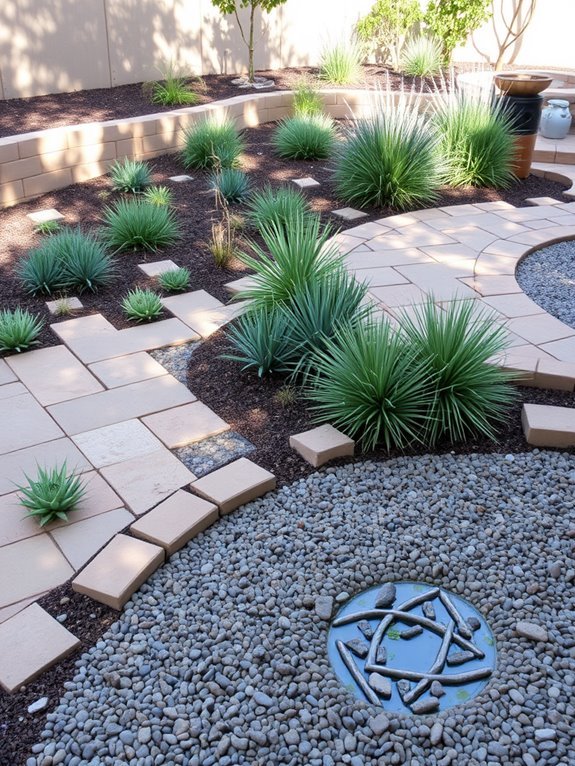
Drip irrigation isn't the only way to boost your garden's water efficiency; permeable paving is an innovative solution for stormwater management.
Imagine your driveway or patio acting as an ally in water conservation! Permeable paving allows rainwater to soak through, reducing puddles and restoring groundwater.
You can select from materials like porous asphalt, permeable concrete, or interlocking pavers, each offering unique aesthetics to create a stylish and functional space.
Plus, it helps recharge groundwater—benefiting your plants and the environment!
No one enjoys dealing with soggy yards or annoying puddles. With permeable paving, you can eliminate these issues while keeping your landscape dry and appealing.
When planning your drought-resistant garden, consider permeable paving—a smart choice for your garden, wallet, and Mother Earth!
Greywater Recycling
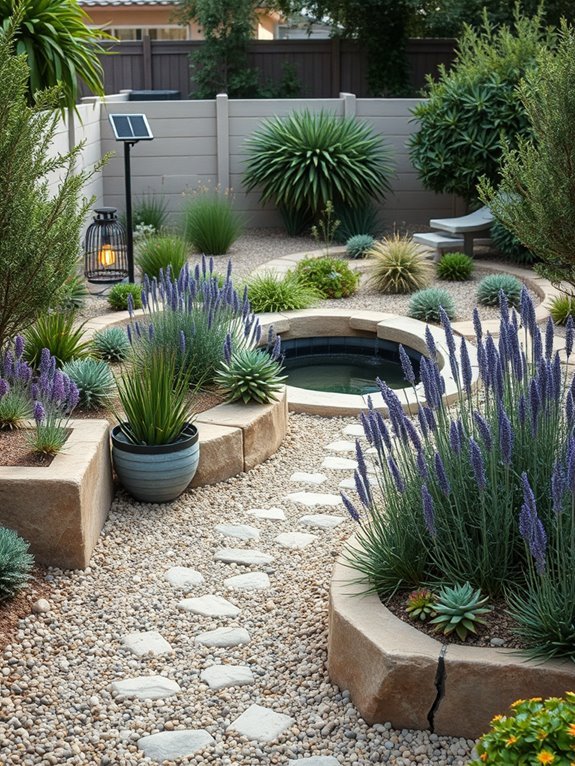
Greywater recycling significantly boosts your home's water conservation.
But what's greywater? It's the clean water from sinks, showers, and washing machines—not toilets! By reusing this water, you reduce overall usage and cut down on bills.
Imagine using that water to nourish your garden or flush toilets. You can easily set up a greywater system to collect and redirect it.
Remember a few guidelines: use eco-friendly soaps and detergents to protect your plants, and check local regulations, as they vary.
Once you get the hang of greywater recycling, you'll feel like a water-saving superhero, making a positive impact on the planet, one drop at a time.
Embrace the adventure and watch your garden thrive!
Vertical Gardening
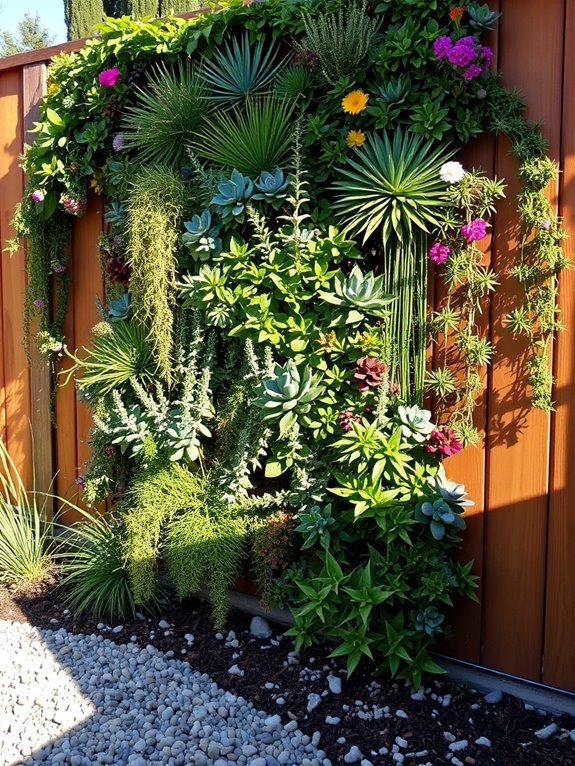
Limited space doesn't mean you can't have a garden—vertical gardening changes that. With this technique, you can transform walls into lush oases featuring hanging planters, wall-mounted pots, or repurposed pallets filled with vibrant herbs, flowers, and veggies.
It's a refreshing makeover for your outdoor space!
Vertical gardening saves space and conserves water by reducing soil evaporation and maximizing moisture use. Many systems incorporate drip irrigation, ensuring plants receive the perfect amount of water without wastage.
These gardens also serve as playful conversation starters. Show off your green thumb with unique succulents in quirky pots for instant charm!
Whether you have a tiny balcony or a cozy corner in your yard, vertical gardening can create a thriving green sanctuary. Let your creativity flourish!
Shade Structures
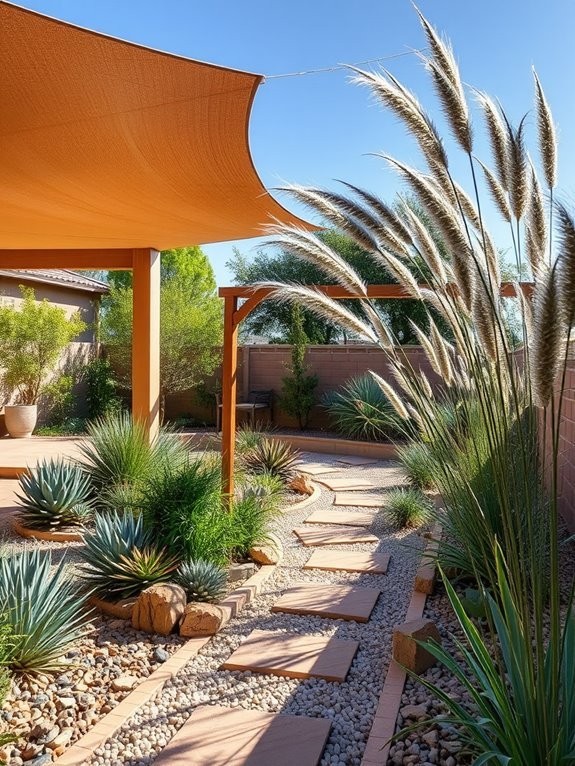
Creating a comfortable outdoor space is vital for enjoying your garden, and shade structures play a key role. They offer sun relief and add character to your backyard.
Picture sipping lemonade under a charming pergola or relaxing on a patio with a sleek awning.
Consider these shade structure options:
- Pergolas: Stylish frames that allow light but block harsh rays—ideal for climbing plants.
- Canopies: Easy to set up or take down, perfect for gatherings.
- Umbrellas: Versatile options available in various sizes and colors.
- Shade sails: Modern designs that can be adjusted for optimal sun protection.
These choices will help you create a shaded retreat that encourages relaxation while conserving water by reducing evaporation.
Enhance your outdoor space with a stunning pergola that not only provides shade but also transforms your backyard into a charming retreat with its stylish design.
Water-Saving Garden Decor
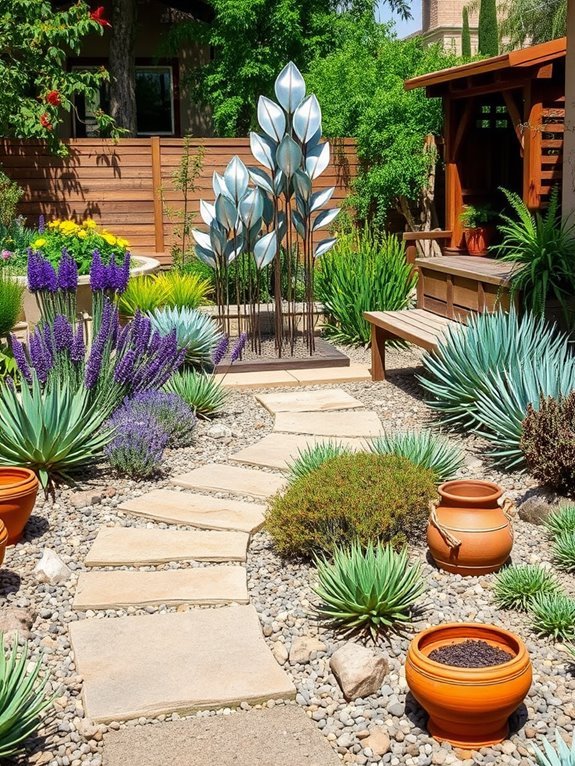
Incorporating water-saving garden decor enhances your outdoor space while promoting efficient water usage. Brighten your yard with colorful, drought-tolerant pots filled with succulents or native plants that thrive on minimal water—perfect for an eco-friendly oasis.
Add rain barrels to collect rainwater, positioned under your downspouts, providing a sustainable watering source without waste.
Consider decorative gravel paths or pebbled areas, which are stylish and reduce mowing and watering needs.
You can also include whimsical garden art—like a funny gnome or funky wind chime—to keep your space cheerful.
Frequently Asked Questions
How Do I Maintain My Drought-Tolerant Garden During a Dry Season?
Maintaining your garden during a dry season can be a fun challenge!
First, check your plants' needs; some might need a little extra love. Water deeply but less often, letting the soil dry out between drinks.
Mulch helps retain moisture and keeps those pesky weeds at bay.
Don't forget to prune and deadhead your plants; it keeps them looking fabulous!
Soon, you'll have a garden that thrives, even in the heat! Enjoy the process!
Can I Incorporate Edible Plants in a Drought-Resistant Landscape?
Absolutely, you can spice up your landscape with edible plants!
Think of it as a culinary adventure in your own backyard. Imagine snacking on juicy tomatoes or crisp peppers while soaking up the sun.
Just pick drought-resistant varieties like herbs, succulents, or certain fruits that thrive on less water.
Your garden could be a tasty escape! So, get planting and enjoy the delicious flavor of sustainability—who knew saving water could taste so good?
What Are the Best Tools for Drought-Tolerant Gardening?
When you're diving into drought-tolerant gardening, you'll want some trusty tools by your side!
A good pair of pruning shears is essential for keeping plants in shape, while a soil moisture meter helps you know when to water.
Don't forget a sturdy trowel for planting those resilient beauties!
And if you can, grab a rain barrel—you'll feel like a gardening superhero collecting nature's water.
Happy gardening, and may your plants thrive!
How Often Should I Water Drought-Tolerant Plants?
Did you know that some drought-tolerant plants can survive on just 1 inch of water a month? That's like skipping your morning coffee!
You should water these resilient beauties once every two weeks, but adjust based on your climate and soil type.
Always check the soil first; if it's still moist, hold off.
Are There Any Pests That Thrive in Drought-Resistant Gardens?
You might be surprised, but some pests do thrive in drought-resistant gardens!
For instance, aphids and spider mites love the heat and dry conditions. They can munch on your plants, causing some headaches.
But don't worry too much! Keeping an eye on your plants and introducing beneficial insects like ladybugs can help.
Plus, a little water now and then can keep your garden happy and less appealing to those pesky critters!
Conclusion
Ready to transform your backyard into a drought-tolerant paradise? With these tips, you can save water while showcasing your gardening skills.
Say goodbye to a water-sucking lawn and hello to a vibrant garden. Imagine your friends marveling at your succulent rock garden while you relax under a shade structure.
Embrace the drought and let your garden thrive. Who knew being eco-friendly could be this enjoyable?
